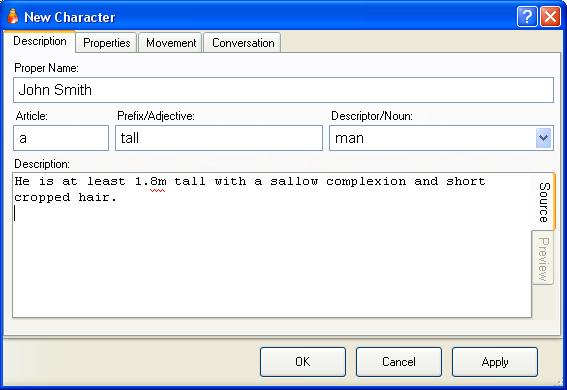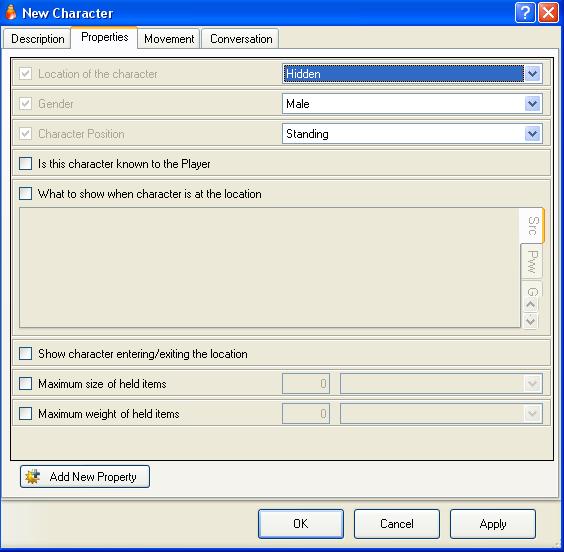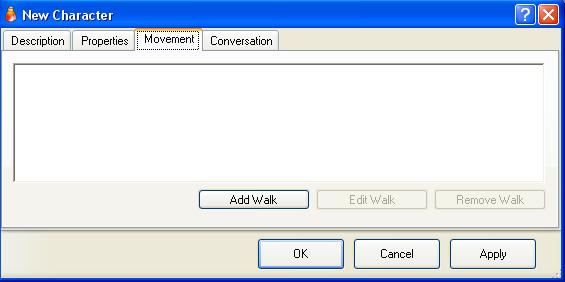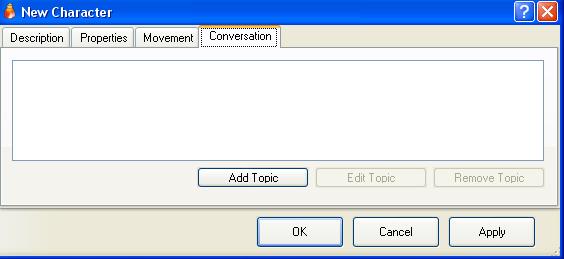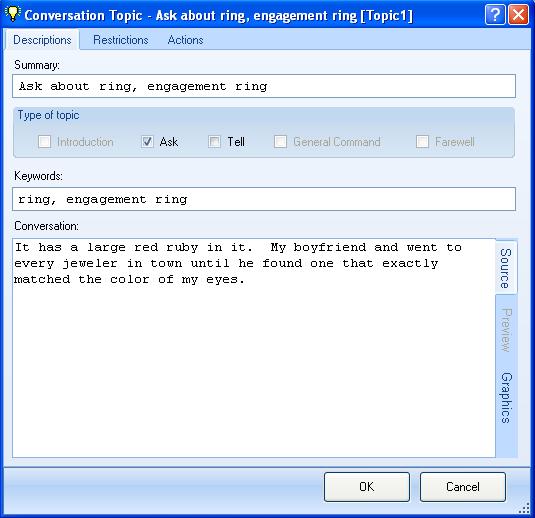Difference between revisions of "Characters"
(Added pictures) |
(→Description) |
||
| Line 1: | Line 1: | ||
== Description == | == Description == | ||
[[File:CharacterDescription.jpg]] | [[File:CharacterDescription.jpg]] | ||
| + | |||
| + | The Proper Name is the actual name of the character. This name is displayed to the player when the character is in the same location, and is entered by the player when they want to refer to the character. | ||
| + | |||
| + | This is only used if this character has the "Known to player" property. | ||
| + | |||
| + | If not, then the Article, Prefix/Adjective and Descriptor/Noun are used to describe what the character looks like, and can be entered by the player to refer to the character. | ||
| + | |||
| + | More than one noun can be entered, on different lines, and the player can use any of them to refer to the character. | ||
| + | |||
| + | The adjectives are optional, except where two characters in the same location use the same noun and it is necisary to distinguish between them. | ||
| + | |||
| + | If the character is described as "a tall thin chinese man" then the player can enter any combination of adjectives, such as "tall chinese man", "thin man", "tall thin man" etc. | ||
| + | |||
| + | A character can start out as unknown to the player but later learn their name. In this case you would use a task to set the "Known to player" property when they learn their name. | ||
| + | |||
| + | The "Description" text box is what is displayed when the player examine's the character. | ||
| + | |||
== Properties == | == Properties == | ||
[[File:CharacterProperties.jpg]] | [[File:CharacterProperties.jpg]] | ||
Revision as of 06:44, 1 May 2012
Description
The Proper Name is the actual name of the character. This name is displayed to the player when the character is in the same location, and is entered by the player when they want to refer to the character.
This is only used if this character has the "Known to player" property.
If not, then the Article, Prefix/Adjective and Descriptor/Noun are used to describe what the character looks like, and can be entered by the player to refer to the character.
More than one noun can be entered, on different lines, and the player can use any of them to refer to the character.
The adjectives are optional, except where two characters in the same location use the same noun and it is necisary to distinguish between them.
If the character is described as "a tall thin chinese man" then the player can enter any combination of adjectives, such as "tall chinese man", "thin man", "tall thin man" etc.
A character can start out as unknown to the player but later learn their name. In this case you would use a task to set the "Known to player" property when they learn their name.
The "Description" text box is what is displayed when the player examine's the character.
Properties
Movement
Conversation
When you press the "Add Topic" button on the "Conversation" tab of a character, the conversation topic dialog opens:
The summary field is just a description to remind you what this conversation is about. The "Type of topic" checkboxes determine what commands this conversation responds to, and whether the next field is disabled (simple Introduction or farewell), A keyword list (Ask or Tell), or a general command. At the bottom is the Conversation text box which is the output of the conversation.
Ask is the equivalent of conversations in v4. Keywords can be specified, and are triggered on ask character about subject tasks. The keywords are listed using comma's to separate them as shown in the image above. Note that a keyword can actually be a short phrase rather than a single word.
Tell works the same as Ask, obviously with a tell character about subject task.
General Command allows you to set a statement of what can be said, using Advanced Command Construction or Wildcards, much like task command matching. These are triggered with a say <whatever> to character task.
The player is either in conversation with a character, or is not.
General Commands can be flagged as Introductions or Farewells. These become explicit introductions/farewells. That means the command will either enter you into conversation with a character, or leave the conversation with that character. So for example, you could create a general command "[hello/hi]". So if you then typed the command "say hello to campbell" it would enter the player into conversation with Campbell.
Introductions/Farewells can also be set without a general command. These become implicit introductions/farewells. If the player starts talking to a character without using an explicit intro, the implicit intro (if it exists) will kick in automatically before the particular command.
So for example, if the player isn't currently in conversation with Campbell and just types "ask campbell about adrift", and you have an implicit introduction defined, you might get the following:
Campbell looks up from his computer as you start to speak. <- implicit intro "Hey Campbell, how're you getting on with ADRIFT?", you ask. Campbell smiles. "I'm getting there. Thanks for asking."
If, for example, you don't type an explicit farewell, such as "bye", and the conversation is ended (for example, you start conversation with another character, or you leave the room), any implicit farewells will be triggered. So for example, in the case about you might have:
Campbell turns back to his computer and resumes coding furiously. <- implicit farewell You move south.
Nodes are just each entry within the conversation tree. You might want to stay at a particular node within the tree until a specific choice is made, hence the checkbox.
You can use restrictions on the conversation nodes to prevent them from being asked a second time. Or if it's simply a matter of changing the displayed output, you can use the alternative descriptions within that node.
